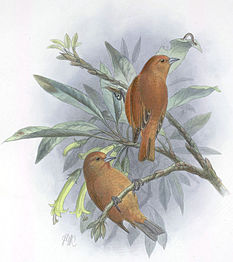- Oʻahu ʻAkepa
-
Oahu Ākepa 
Conservation status Scientific classification Kingdom: Animalia Phylum: Chordata Class: Aves Order: Passeriformes Family: Drepanididae Genus: Loxops Species: L. coccineus Subspecies: L. c. wolstenholmei Trinomial name Loxops coccineus wolstenholmei
Rothschild, 1895Synonyms - Fringilla rufa Bloxam, 1827 (preoccupied)
- Loxops wolstenholmei Rothschild, 1895
The Oʻahu ʻAkepa (Loxops coccineus wolstenholmei) is an extinct subspecies of the ʻAkepa that was endemic to the island of Oahu. It was commonly sighted throughout the 19th century. This brick red Hawaiian honeycreeper was found in the mountain peaks in densely forested areas. The females were mostly gray with a tinge of green. The birds had a slight crossbill just like the other Loxops species. It used its crossbill to open up buds in search for nectar and insects for it to eat. Its most common haunts were the O’hia and Koa forests that were filled with the many flowers and insects that this species liked to eat. The Oahu Akepa is one of three different species of Akepa that were spread by possible weather and migration. The movement of the species stopped causing the species to break into four branches. The first branch was the Hawaiian Akepa, a scarlet- red bird it lives only on the Big Island and may be the ancestor of the Loxops genus. Next is the Maui Akepa, it was found as fossils on all the islands of Maui Nui, but was historically seen on Maui. It is a greyish-orange bird that was the first of the Akepa species to disappear. Then came the Oahu Akepa, it is a brick red color and was seen till around the 1990s when it became extinct. Finally the last branch was the Akeke’e, a green bird that is only found on the island of Kauai. It is thought as a different species while the other three were subspecies of the Akepa, which still exists on Hawai’i.
References
- BirdLife International 2004. Loxops coccineus wolstenholmei. 2006 IUCN Red List of Threatened Species. Downloaded on 19 July 2007.[dead link]
Categories:- IUCN Red List extinct species
- Bird extinctions since 1500
- Extinct birds
- Animals described in 1895
- Extinct Hawaiian animals
Wikimedia Foundation. 2010.

